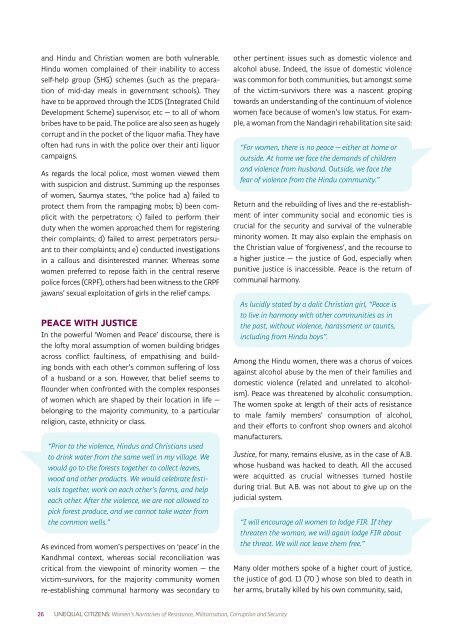CC_India
CC_India
CC_India
You also want an ePaper? Increase the reach of your titles
YUMPU automatically turns print PDFs into web optimized ePapers that Google loves.
and Hindu and Christian women are both vulnerable.<br />
Hindu women complained of their inability to access<br />
self-help group (SHG) schemes (such as the preparation<br />
of mid-day meals in government schools). They<br />
have to be approved through the ICDS (Integrated Child<br />
Development Scheme) supervisor, etc — to all of whom<br />
bribes have to be paid. The police are also seen as hugely<br />
corrupt and in the pocket of the liquor mafia. They have<br />
often had runs in with the police over their anti liquor<br />
campaigns.<br />
As regards the local police, most women viewed them<br />
with suspicion and distrust. Summing up the responses<br />
of women, Saumya states, “the police had a) failed to<br />
protect them from the rampaging mobs; b) been complicit<br />
with the perpetrators; c) failed to perform their<br />
duty when the women approached them for registering<br />
their complaints; d) failed to arrest perpetrators persuant<br />
to their complaints; and e) conducted investigations<br />
in a callous and disinterested manner. Whereas some<br />
women preferred to repose faith in the central reserve<br />
police forces (CRPF), others had been witness to the CRPF<br />
jawans’ sexual exploitation of girls in the relief camps.<br />
PEACE WITH JUSTICE<br />
In the powerful ‘Women and Peace’ discourse, there is<br />
the lofty moral assumption of women building bridges<br />
across conflict faultiness, of empathising and building<br />
bonds with each other’s common suffering of loss<br />
of a husband or a son. However, that belief seems to<br />
flounder when confronted with the complex responses<br />
of women which are shaped by their location in life —<br />
belonging to the majority community, to a particular<br />
religion, caste, ethnicity or class.<br />
“Prior to the violence, Hindus and Christians used<br />
to drink water from the same well in my village. We<br />
would go to the forests together to collect leaves,<br />
wood and other products. We would celebrate festivals<br />
together, work on each other’s farms, and help<br />
each other. After the violence, we are not allowed to<br />
pick forest produce, and we cannot take water from<br />
the common wells.”<br />
As evinced from women’s perspectives on ‘peace’ in the<br />
Kandhmal context, whereas social reconciliation was<br />
critical from the viewpoint of minority women — the<br />
victim-survivors, for the majority community women<br />
re-establishing communal harmony was secondary to<br />
other pertinent issues such as domestic violence and<br />
alcohol abuse. Indeed, the issue of domestic violence<br />
was common for both communities, but amongst some<br />
of the victim-survivors there was a nascent groping<br />
towards an understanding of the continuum of violence<br />
women face because of women’s low status. For example,<br />
a woman from the Nandagiri rehabilitation site said:<br />
“For women, there is no peace — either at home or<br />
outside. At home we face the demands of children<br />
and violence from husband. Outside, we face the<br />
fear of violence from the Hindu community.”<br />
Return and the rebuilding of lives and the re-establishment<br />
of inter community social and economic ties is<br />
crucial for the security and survival of the vulnerable<br />
minority women. It may also explain the emphasis on<br />
the Christian value of ‘forgiveness’, and the recourse to<br />
a higher justice — the justice of God, especially when<br />
punitive justice is inaccessible. Peace is the return of<br />
communal harmony.<br />
As lucidly stated by a dalit Christian girl, “Peace is<br />
to live in harmony with other communities as in<br />
the past, without violence, harassment or taunts,<br />
including from Hindu boys”.<br />
Among the Hindu women, there was a chorus of voices<br />
against alcohol abuse by the men of their families and<br />
domestic violence (related and unrelated to alcoholism).<br />
Peace was threatened by alcoholic consumption.<br />
The women spoke at length of their acts of resistance<br />
to male family members’ consumption of alcohol,<br />
and their efforts to confront shop owners and alcohol<br />
manufacturers.<br />
Justice, for many, remains elusive, as in the case of A.B.<br />
whose husband was hacked to death. All the accused<br />
were acquitted as crucial witnesses turned hostile<br />
during trial. But A.B. was not about to give up on the<br />
judicial system.<br />
“I will encourage all women to lodge FIR. If they<br />
threaten the woman, we will again lodge FIR about<br />
the threat. We will not leave them free.”<br />
Many older mothers spoke of a higher court of justice,<br />
the justice of god. IJ (70 ) whose son bled to death in<br />
her arms, brutally killed by his own community, said,<br />
26 UNEQUAL CITIZENS: Women’s Narratives of Resistance, Militarisation, Corruption and Security


